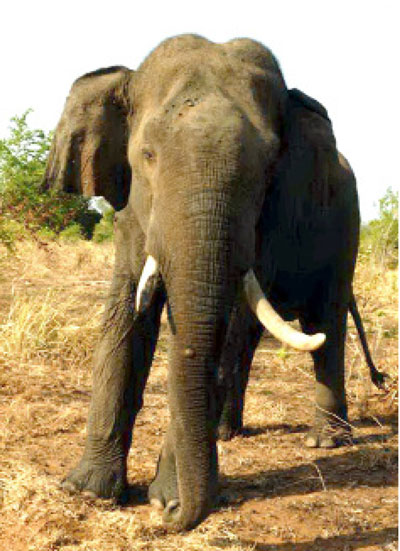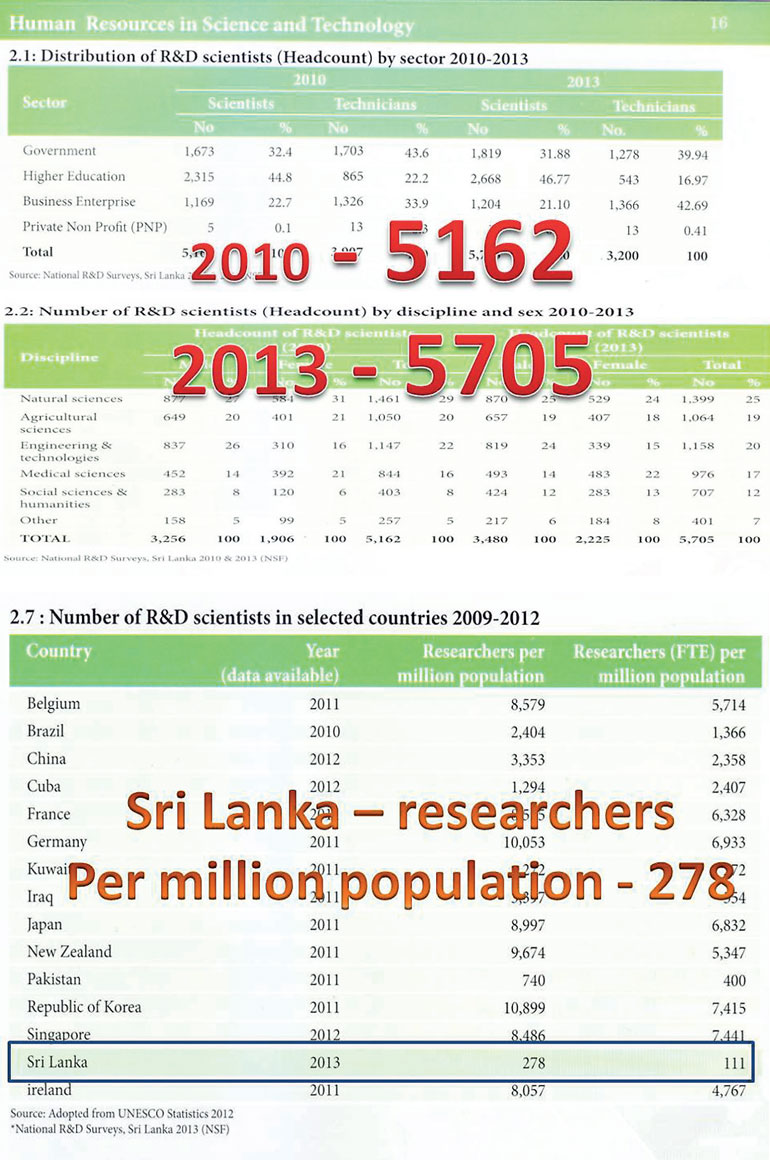Tuesday Dec 23, 2025
Tuesday Dec 23, 2025
Thursday, 8 December 2016 00:01 - - {{hitsCtrl.values.hits}}
 John Dewey said that “every great advance in science has come from a new audacity of imagination” and these acts of imagination have to come from researchers. The numbers for Sri Lanka appear to be really worrying as the critical mass necessary is seriously missing.
John Dewey said that “every great advance in science has come from a new audacity of imagination” and these acts of imagination have to come from researchers. The numbers for Sri Lanka appear to be really worrying as the critical mass necessary is seriously missing.
Research is investing money to generate knowledge. Today in Sri Lanka the country’s investment on R&D is estimated to be around 0.16% of GDP. This is not adequate and well below that of a LDC. Yet on actual terms some millions of US Dollars are spent on research and development.
In the public space there are around 66 research institutes and university faculties in the area of science and technology. These are spread over 21 line ministries. There is a trend of private sector research in science and technology growing too. As there is clearly a business intention when private sector R&D is taking place, there is much less visibility of quantitative data on private investments.
Scarcity of researchers
Innovation step returns money back based on the knowledge generated through investments. The first step is vital as innovation depends on research and research is primarily a researcher activity. Hence the importance of research is undisputed and the whole process depends on persons with integrity, patience and creativity. Researchers can come from many strata with research  academics at universities and senior research scientists at institutions crowding the apex of positions.
academics at universities and senior research scientists at institutions crowding the apex of positions.
There is no accurate current estimate of number of researchers (both full time and part time) and the process of estimation is not yet dynamic. Hopefully the Sri Lanka Innovation Dashboard which bagged the first place in recent e-Swabhimani awards in the Government category will provide us with a dynamic display of status. However, individual participation is vital to make the process a success.
Sri Lanka Innovation Dashboard expects to capture research and researchers and inventors at all levels. As per the National Science Technology and Innovation strategy document, the total number of all available researchers with PhDs in Universities at present in Sri Lanka is 1,160 (of which only less than 300 are currently supervising research degrees – producing an average of 20-50 research degrees a year, by 16 universities). This number of supervisors is inadequate to train the target of 20,000 researchers.
The larger number comes from UNESCO’s identified rule of thumb of number of researchers required to an economy of Sri Lanka which is a lower middle income economy. The value indicated for Sri Lanka is 278 in the 2013 estimate. Compare the position of Singapore with over 8,000 per million of population. There is definitely a scarcity of researchers.
We give great attention to elephants. An entire industry more or less depends on the presence of these majestic animals and religious places too cry foul when they cannot get the numbers necessary to parade on streets. All the interest however is not based on the welfare of the animals. The statistics indicate that the number of elephant population to be from 5,000-5,600 as per Department of Wildlife data. It appears that we more or less have the same number of elephants as researchers! While we really worry over the decline of the elephant population, researchers have been given scant attention. The repercussions are not on just one industry but on the whole economy.
Indian example
I place this story that is circulating with a purpose. Also being at Indian Institute of Science which is a Postgraduate Research University (modelled as per the John Hopkins University of USA) I know the relevance and the contribution that it makes. This is where high-end research is carried out within the country as in this case for India.
“Jamshedji Nusserwanji Tata was once, travelling to Europe. As he stood there, at the door of his First Class Cabin in the steamliner, he noticed a lot of activity on the lower decks of the ship. On inquiring, he learned that a great Indian Saint, Shri Swami Vivekananda, was on board the same ship. Out of genuine respect and curiosity, J.N. Tata decided to pay a visit to the great saint.
“Swami Vivekananda had, of course, heard about the respected industrialist. As the conversation grew J.N. Tata explained that he was on his way to Germany. ‘I have with me sacks of soil: From various parts of India. I am taking these samples of soil to Germany. I wish to know if iron can be extracted profitably from any of these districts,’ said J.N. Tata to the Saint, to which Swami Vivekananda replied, ‘Well, Sir, even if these sacks contain iron-rich soil, do you honestly believe that the Europeans will tell you the truth? You must understand that no/none of the European Nations wish to see a strong/steel-rich/economically independent India. The soil is probably rich in iron-ore but the sad truth is all you will get from your inquiries across Europe is disbelief and pessimistic reactions.
“Needless to say, having interacted with several Europeans J.N. Tata knew this to be true. Swami Vivekananda continued, ‘Why don’t you start an excellent/up-to-date research facility and college here in India? Why don’t you train some good Indian youngsters to identify soil and conduct these tests and find ways of profitably extracting metals? It may seem like a wasteful; burdensome expenditure right now, but in the long run – it will save you many trips to Europe and you can have the assurance of knowing the truth quickly – rather than taking multiple opinions due to doubt.’
“As he could clearly sense J.N. Tata’s mood was in acquiescence, he further elaborated, ‘Seek an audience with the Maharaja of Mysore H.R.H. Wodeyar. Though a subordinate of the British, he will definitely help you in every way he can. H.R.H. Wodeyar has been generous enough to sponsor my own trip to Chicago to attend the Parliament of Religions.’ As soon as he returned to India, J.N. Tata headed straight for Mysore. And indeed, H.R.H. Chamraja Wodeyar did not disappoint him. The King granted 370 acres of land for the setting up of the Research Facility and College that J.N. Tata had envisioned and it was named the Indian Institute of Science.”
What is clearly indicated is most of the times crucial answers to your questions one needs to source from within. Thus when countries have critical mass of researchers there is the generation of knowledge and if the rest of the eco-system is present there is the option of investment of knowledge to generate revenue to the economy. These simple representations indicate the urgency for us in addressing this dearth.
This situation cannot be rectified overnight. Starting from higher purposeful investments by the Government, the task has to move forward within a defined timeframe. The political leadership has to come to a clear understanding of this national need and its potential returns upon implementation.

Research to the fore
When research is at frontiers there is the blurring of discipline boundaries. Today there is so much excitement at subject interfaces. The three dominant technology areas – information technology, biotechnology and nanotechnology – are spawning many an area in areas of convergence. Almost unique developments are prophesied where all three converge. Bioinformatics was convergence of biotechnology and information technology.
Nanobiotechnology and bionanotechnology areas result from the interface of bio and nanotechnologies. Quantum computing is when nanotechnology and information technology interacts. The area where triple convergence occurs is an exciting frontier to be considered. One must admit that there is a fourth area that is emerging – neurotechnology (cognitive sciences) which push the boundaries even further.
Sri Lankan researchers through networking can and should engage in frontier research. If we strategically understand the research space there are areas where not only we can participate but perhaps lead too. Biomimetics offer significant opportunity. The combination of indigenous medicinal systems with modern science is another area. If Sri Lanka understands the value of strategic investments as had been shown with Sri Lanka Institute of Nanotechnology (SLINTEC) host of other areas definitely opens up with possibilities – advanced nanomaterials and applications, information technologies in interfaces, renewable energy systems (biogas, microbial fuel cells, etc.).
With so many opportunities for engagement one should have an ecosystem which encourages and rewards young researchers to take on the seemingly impossible than stick to well traversed pathways. There again there is a responsibility on the Government in understanding the role of researchers in propelling the position of the country when a critical mass of researchers really get themselves engaged on frontier areas.